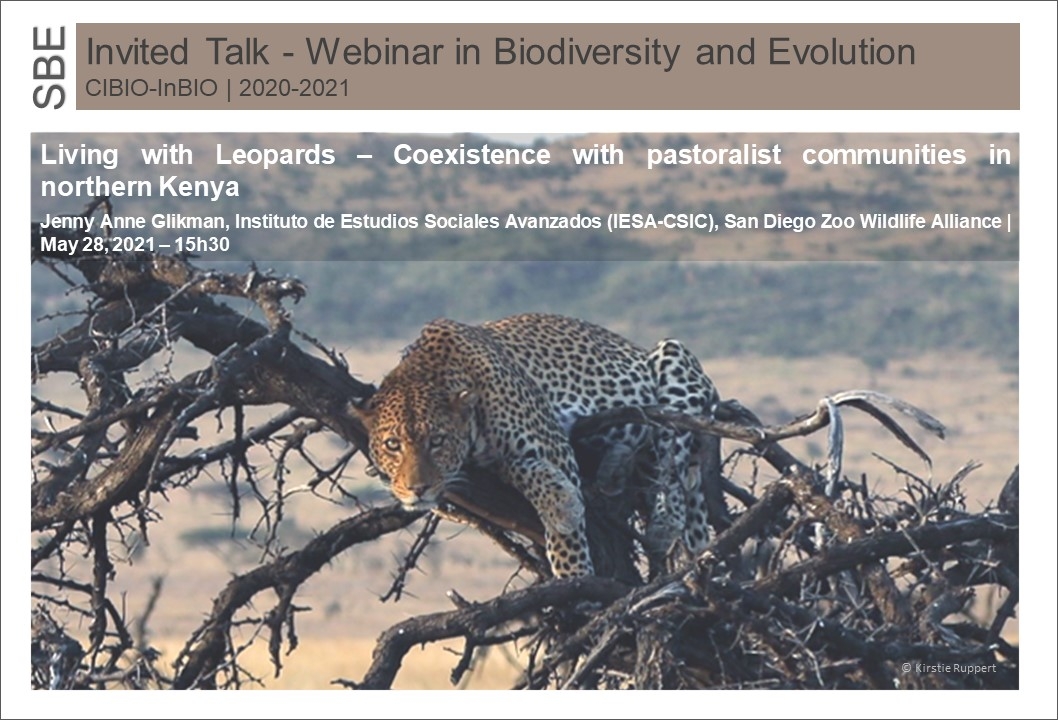Living with Leopards – Coexistence with pastoralist communities in northern Kenya
28 May 2021 - Jenny Anne Glikman, Instituto de Estudios Sociales Avanzados (IESA-CSIC), San Diego Zoo Wildlife Alliance |15h30

INVITED TALK - WEBINAR IN BIODIVERSITY AND EVOLUTION
African leopards (Panthera pardus pardus) are listed as Vulnerable by IUCN, with human-leopard conflict as the greatest source of direct mortality for declining leopard populations. The dynamics of coexistence and conflict between people and wildlife is an omnipresent stressor on communities in Kenya, and especially charged when such negative interaction revolves around pastoralist loss of livestock to carnivores. With most wildlife living outside of government protected areas, Kenya has promoted the conservancy system to build community ownership and, in turn, protection of their biodiversity. However, a lack of scientific knowledge and research on leopards is a major barrier to creating a management strategy. The Leopard Conservation Program was established in Laikipia County, Kenya in 2017, with the goal of developing science-based management strategies to promote sustainable leopard populations that can coexist with humans. Leopard Conservation Program focuses on long-term capacity building of local communities for conservation through direct employment and education related to wildlife research, management, and protection. The project’s objectives are to assess the range, density and status of the target species, and develop local, adaptive management plans to improve human-wildlife coexistence in northern Kenya’s rangelands.
Dr. in Human Geography and currently senior researcher for the Instituto de Estudios Sociales Avanzados (IESA-CSIC), Cordoba, Spain. She worked as a professor/researcher in the department of Human Ecology at a National Center of Investigations (CINVESTAV-Mérida) in Mexico, focusing in understanding the historical and cultural establishment of marine and terrestrial protected areas. Then, she worked for six years as associate director within the Community Engagement Team of the San Diego Zoo’s Institute for Conservation Research (SDZWA), in California. Currently, she still collaborates with the SDZWA in international programs in Sud America, Africa and in S.E. Asia on programs focused on human-wildlife interaction and illegal wildlife trade.
Overall, her research focus in understanding the relationships between humans and nature and wildlife in order to tackle conflicts that threats biodiversity conservation and human activities. This helps to develop solutions that best support conservation actions and build capacity locally to achieve human-wildlife coexistence.
Currently she is an associate editor for Frontiers in Conservation Science and a senior associate editor for Conservation Science and Practice. In addition, she is an elected board member of the "Human Bear Conflict Expert Teams” and a steering committee member of the "Human-Wildlife Conflict Task Force” of the International Union for Nature Conservation.
[Host: Paulo Célio Alves, Conservation Genetics and Wildlife Management - CONGEN]
Click here to watch the webinar recording
Click here to watch the webinar recording